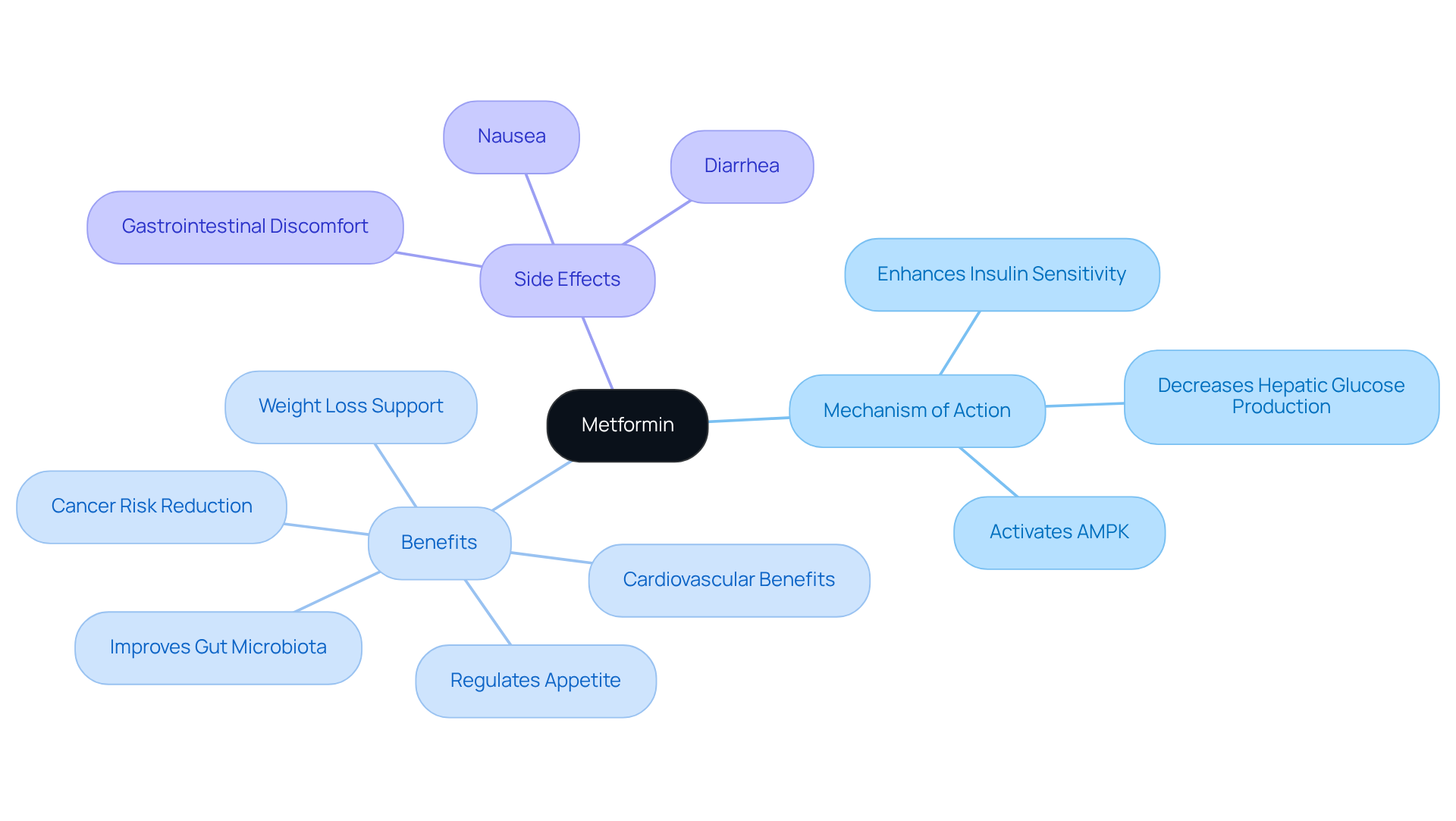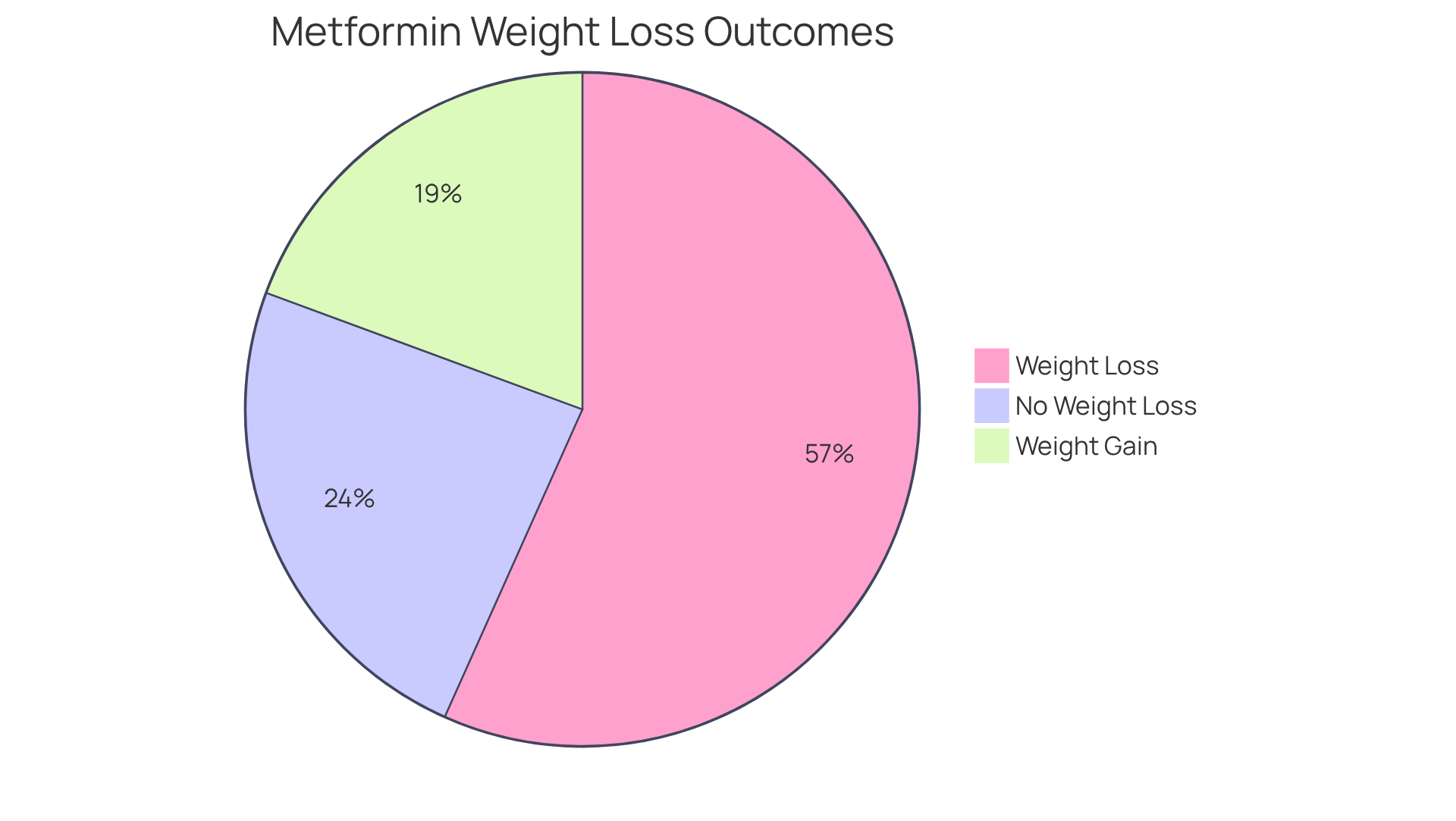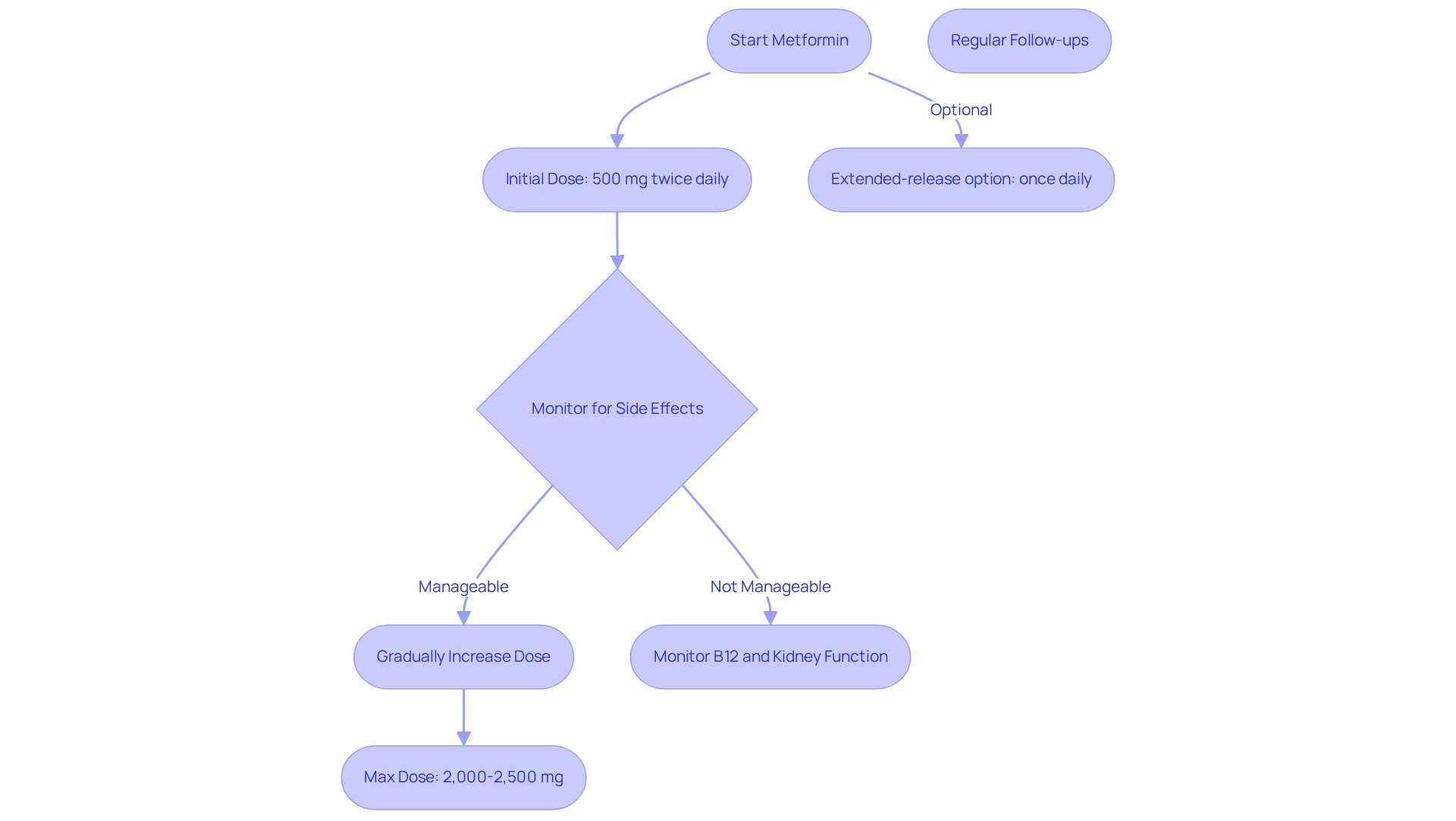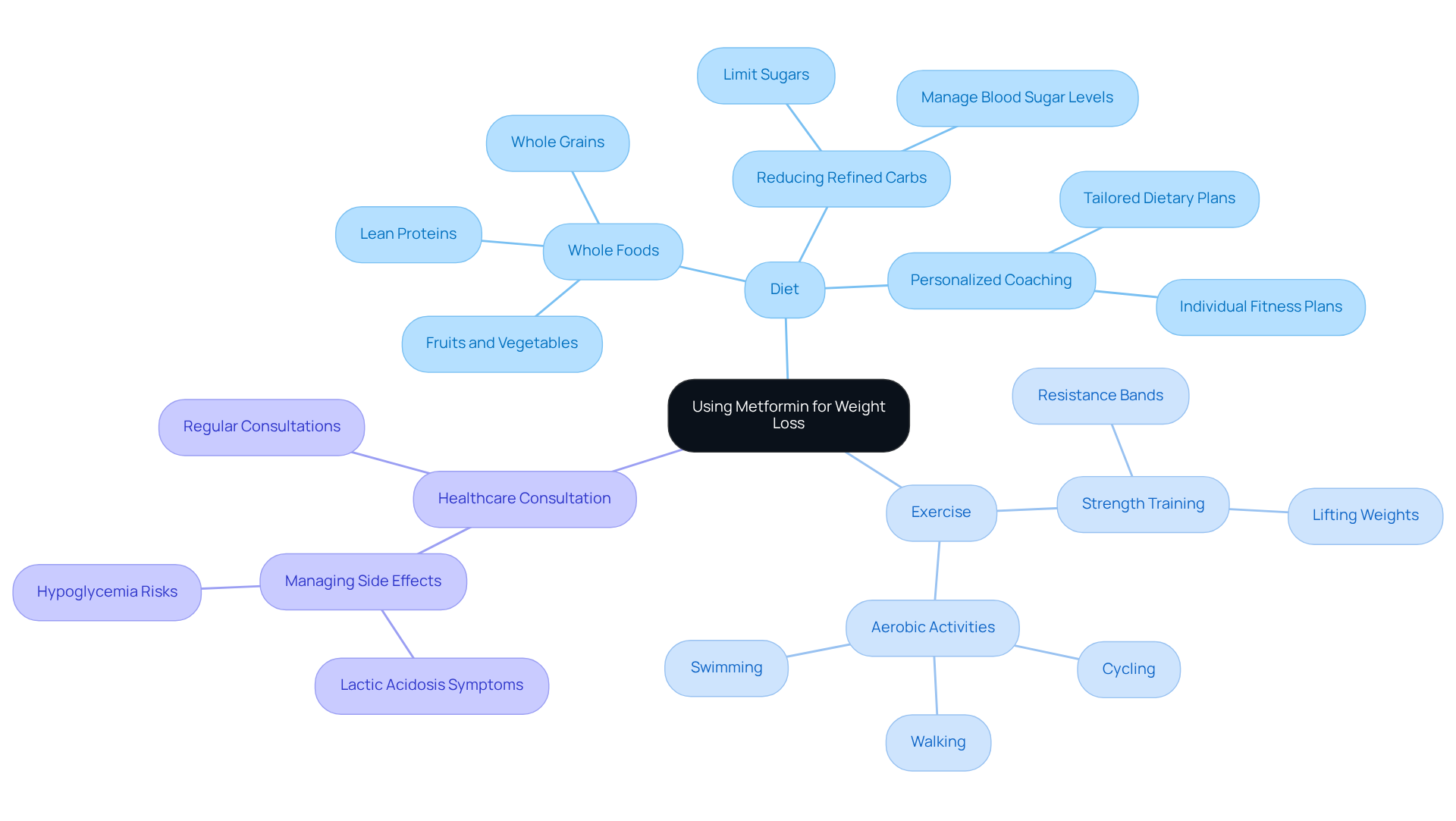Overview
If you’re considering using metformin for weight loss, it’s important to remember that combining this medication with a balanced diet and regular exercise can truly enhance its effectiveness. Many individuals face challenges on their weight loss journey, and understanding that metformin can lead to an average weight loss of about 5.8 kg over six months is encouraging. This weight loss primarily occurs through appetite reduction and better blood sugar management, which can make a significant difference in how you feel.
Moreover, adhering to lifestyle modifications is crucial; it can significantly improve your outcomes. Remember, you’re not alone in this journey. Together, we can achieve your goals, and with the right support and commitment, positive changes are within reach. Have you considered how small adjustments in your daily routine could lead to meaningful progress? We’re here for you, every step of the way.
Introduction
Managing weight can feel like an overwhelming challenge, particularly for those facing insulin resistance or obesity. Metformin, a medication primarily used for type 2 diabetes, has emerged as a potential ally in your weight loss journey. It offers not only improved blood sugar control but also helps regulate appetite. Yet, as you embark on this path, important questions arise:
- How can you maximize the benefits of metformin?
- What role do lifestyle changes play in achieving sustainable results?
Understanding these dynamics is essential for anyone looking to unlock the full potential of metformin in their weight loss journey. Together, we can navigate these challenges and work towards your goals.
Understand Metformin: Mechanism and Uses
Managing type 2 diabetes can feel overwhelming, but this medication offers a compassionate solution. Primarily, it enhances insulin sensitivity and decreases hepatic glucose production, helping to stabilize your blood sugar levels. By activating AMP-activated protein kinase (AMPK), it plays a crucial role in maintaining energy balance within your cells. This activation not only reduces glucose production in the liver but also promotes glucose uptake in muscle tissues, supporting your overall health.
Moreover, this medication positively influences gut microbiota and increases the secretion of glucagon-like peptide-1 (GLP-1), a hormone that helps regulate appetite and glucose metabolism. Understanding these processes is vital, especially for those of you facing challenges with insulin resistance or obesity. This medication can be a valuable ally in your weight loss journey, especially when learning how to use metformin for weight loss, as it also helps manage body mass by reducing cravings for high-calorie foods.
However, it’s important to be aware of potential side effects, such as gastrointestinal discomfort, including nausea and diarrhea, particularly during the initial weeks of treatment. We want you to feel supported and informed, so understanding these advantages and safety considerations is essential for your health management. Together, we can navigate this journey towards achieving your goals with confidence and care.
Explore Metformin’s Role in Weight Loss
Recent studies highlight the promise of this medication in promoting slight reductions, particularly for those grappling with obesity or metabolic syndrome, and provide insights on how to use metformin for weight loss. While metformin is primarily authorized for managing type 2 diabetes and not specifically approved as a standalone treatment for weight loss, understanding how to use metformin for weight loss can lead patients to lose approximately 5.8 kg (around 12.8 lbs) over six months, according to clinical studies. They may also see an average reduction of about 2% to 3% of their body mass within the first year of therapy. This decrease is largely attributed to the medication’s ability to curb appetite by enhancing hormones that signal fullness.
It’s important to note that individuals who understand how to use metformin for weight loss and complement their medication routine with a balanced diet and regular exercise often achieve even more significant results in their weight loss journey. However, it’s essential to acknowledge that weight loss outcomes can vary greatly among participants. Some may experience considerable reductions, while others might not lose any weight at all. In fact, untreated controls gained an average of 0.8 kg during the same period, underscoring the medication’s effectiveness in managing body mass.
Side effects, such as nausea and diarrhea, are common and affect over a quarter of patients. This is something to consider when evaluating the overall benefits of this medication. Remember, this synergistic approach—combining medication with lifestyle modifications—includes understanding how to use metformin for weight loss, which is crucial for fostering sustainable weight loss and enhancing overall health. Together, we can achieve your goals and support each other on this journey.
Implement Metformin: Dosage and Administration Guidelines
Starting this medication often begins with a low dosage, a thoughtful approach designed to minimize gastrointestinal side effects. For immediate-release formulations, the standard initial dose is 500 mg, taken twice daily with meals. This method not only helps alleviate discomfort but also emphasizes the importance of consuming the medication with food to reduce gastrointestinal issues. As you become more accustomed to the medication, your healthcare provider may gradually increase the dosage, with a maximum recommended daily dose ranging from 2,000 to 2,500 mg. For those seeking convenience, extended-release formulations allow for once-daily administration, which may enhance adherence for some patients.
Regular follow-ups with your healthcare provider are essential. These check-ins help monitor your progress and enable necessary dosage adjustments. Many patients find that starting low and increasing gradually can effectively manage side effects. In fact, a study highlighted that individuals who adhered to a gradual increase in dosage reported fewer gastrointestinal complaints, ultimately enhancing their overall experience with the medication.
It’s important to be aware of common side effects, such as nausea and diarrhea, which may affect more than 1 in 100 individuals. Pharmacists often recommend practical strategies to help manage these side effects. For example, consider taking smaller, more frequent meals and ensuring you stay hydrated. Additionally, this medication can support your weight loss journey by demonstrating how to use metformin for weight loss by decreasing appetite and improving insulin sensitivity, which may help control cravings and limit fat accumulation. This proactive approach not only aids in tolerability but also supports your reduction journey, as consistent medication adherence is vital for achieving your desired outcomes.
Moreover, regular monitoring of vitamin B12 levels and kidney function is crucial for the safe use of this medication, especially for patients with varying GFR levels. Remember, we’re here for you, and together, we can achieve your goals.
Combine Metformin with Diet and Exercise for Optimal Results
To effectively learn how to use metformin for weight loss, it’s essential to adopt a balanced diet alongside a regular exercise regimen. At Minimal, we understand that each journey is unique, which is why we emphasize personalized coaching that tailors dietary and fitness plans to your individual needs. This comprehensive approach to managing body composition can truly make a difference. Imagine a diet abundant in whole foods—fruits, vegetables, lean proteins, and whole grains—all of which can significantly enhance the medication’s effectiveness. Reducing your intake of refined carbohydrates and sugars is also beneficial, as it aligns with how to use metformin for weight loss by helping to manage blood sugar levels and supporting your efforts to reduce body mass.
Incorporating both aerobic and strength training exercises into your weekly routine can further improve insulin sensitivity and promote fat loss. At Minimal, we recommend aiming for at least 150 minutes of moderate-intensity exercise each week. Activities like brisk walking, cycling, or swimming can be enjoyable ways to stay active. Additionally, strength training activities, such as lifting weights or using resistance bands, should be included at least twice a week to help develop muscle and boost metabolism.
Regular consultations with a healthcare provider, as part of Minimal’s holistic health services, are vital in tailoring dietary and exercise plans to your unique needs, particularly in learning how to use metformin for weight loss. This ensures a comprehensive approach to weight management. Our fitness trainers at Minimal encourage you to focus on activities that you enjoy, as maintaining motivation and consistency is key to long-term success. Remember, it’s also important to stay informed about potential side effects of Metformin, such as symptoms of lactic acidosis and hypoglycemia, which are important to discuss with your healthcare provider. Together, we can navigate this journey towards better health.
Conclusion
Understanding how to effectively use metformin for weight loss can be a transformative journey for many individuals managing type 2 diabetes or facing challenges with obesity. This medication not only stabilizes blood sugar levels but also plays a significant role in appetite regulation and energy balance, making it a valuable tool in your weight loss process.
Throughout this guide, we’ve explored how metformin aids in weight loss, highlighting its ability to enhance insulin sensitivity, curb cravings, and promote a sense of fullness. We’ve emphasized the importance of a balanced diet and regular exercise, demonstrating that combining these lifestyle changes with metformin can lead to more substantial and sustainable weight loss results. Additionally, practical dosage and administration guidelines have been provided to ensure safe and effective use of the medication.
Ultimately, the journey to weight loss and improved health is not solely about medication; it encompasses a holistic approach that includes dietary changes, physical activity, and regular medical consultations. Embracing this comprehensive strategy empowers you to achieve your weight loss goals while enhancing your overall well-being. For those considering or currently using metformin, remember: informed choices and a proactive attitude are crucial in unlocking the full potential of this medication on your path to a healthier lifestyle. Together, we can achieve your goals!
Frequently Asked Questions
What is the primary function of Metformin in managing type 2 diabetes?
Metformin primarily enhances insulin sensitivity and decreases hepatic glucose production, helping to stabilize blood sugar levels.
How does Metformin activate AMPK and why is it important?
Metformin activates AMP-activated protein kinase (AMPK), which plays a crucial role in maintaining energy balance within cells. This activation reduces glucose production in the liver and promotes glucose uptake in muscle tissues.
What additional benefits does Metformin provide beyond blood sugar control?
Metformin positively influences gut microbiota and increases the secretion of glucagon-like peptide-1 (GLP-1), a hormone that helps regulate appetite and glucose metabolism.
Can Metformin aid in weight loss?
Yes, Metformin can support weight loss by helping manage body mass and reducing cravings for high-calorie foods, making it a valuable ally for those facing challenges with insulin resistance or obesity.
What are the potential side effects of taking Metformin?
Potential side effects include gastrointestinal discomfort, such as nausea and diarrhea, particularly during the initial weeks of treatment.
Why is it important to understand both the advantages and safety considerations of Metformin?
Understanding the advantages and safety considerations of Metformin is essential for effective health management, as it helps individuals navigate their treatment journey with confidence and care.





















